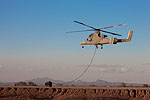ONR's latest gear is a step toward the end of old-school logistics
 In a continued effort to reduce the number of convoys and rapidly resupply front-line troops, the Office of Naval Research recently tested technology that could eventually enable any rotary wing aircraft to take off, complete a mission, and then land with little or no guidance from the ground.
In a continued effort to reduce the number of convoys and rapidly resupply front-line troops, the Office of Naval Research recently tested technology that could eventually enable any rotary wing aircraft to take off, complete a mission, and then land with little or no guidance from the ground.
Reducing the number of convoys is critical to limit exposure of troops to improvised explosive devices, but it also fits in with emerging doctrine of the smaller and more agile military envisioned by the Pentagon. The Corps’ vision seems almost singularly dependent on light-weight, speedy supply delivery doctrine: smaller crisis response units and larger Marine expeditionary brigades launching and establishing toeholds on the fringes of global instability, possibly supplied only occasionally from ships far off shore — a far cry from relying on giant semi-permanent forward operating base logistics hubs.
In terms of limiting the supply line’s dependence on human labor, ONR’s new tech essentially plugs into the electrical guts of rotary wing helicopters and turns their control into an intuitive app on a tablet computer.
Service members at Marine Corps Base Quantico, Va., recently had the chance to demonstrate two versions of what the ONR dubs the Autonomous Aerial Cargo Utility System, which also consists of hardware and software packages that can help an aircraft detect and avoid ground obstacles, even in adverse weather conditions. The trials were conducted in February, with software developed by Aurora Flight Sciences aboard a Boeing H-6U Little Bird, and in March on a Lockheed Martin K-MAX helicopter, using software from the same company.
The system marks a “giant leap in autonomous capabilities” because it can be operated via a hand-held tablet by Marines with no aviation experience, Chief of Naval Research Rear Adm. Matthew Klunder told reporters during a recent roundtable discussion at the Pentagon. He stressed that the Marines who landed the experimental helicopters, a lance corporal and a sergeant, had less than 30 minutes of total training.
“It doesn’t have to be a loader, it doesn’t have to be a pilot; it could be anybody,” Klunder said. “It could be someone that works at Denny’s that needed a rescue at the restaurant. The advantage of what we did was anyone who knows how to look at a tablet, which is most of the world today, and knows how to at least touch one point on that tablet is going to be able to safely land this helicopter at an unprepared site.”
He said that in addition to logistical support, the system had the potential to contribute to unmanned casualty evacuations and humanitarian assistance operations and could one day be installed on a CH-53 helicopter or an MV-22 Osprey.
Marine Corps leadership has pushed hard in recent years to field unmanned helicopters in order to cut down the number of ground convoys in Afghanistan. Convoys transport everything from water to ammunition, making them a prime insurgent target and IEDs a leading cause of casualties.
To that end, the Marine Corps, in cooperation with civilian contractor Lockheed Martin, has flown the K-MAX in Afghanistan since November 2011. The helicopter, which is capable of being flown by a pilot or remotely, can also carry out missions autonomously if given a predetermined destination.
As of March 27, the aircraft had flown more than 1,800 sorties and moved over 4.42 million pounds of cargo, thus eliminating from roadwork the equivalent of more than 500 loaded out seven-ton trucks, according to Capt. Richard Ulsh, a Marine aviation spokesman at the Pentagon.
The 100-pound, “platform agnostic” AACUS suite would require a manned ground control station at a forward operating base that would act “as a dispatch,” assisting the Marine operating the helicopter from the tablet, according to program manager Max Snell. The app itself provides users a visual map overlay that allows them to view the area’s topography, among other features, he said.
Brig. Gen. Kevin Killea, chief of Marine Corps Warfighting Laboratory, said the experimental system takes unmanned flight to the next level by giving platforms even greater autonomy.
“What you have in Afghanistan right now are highly trained operators that have to do detailed planning, especially with the landing sites these Cargo UAS are operating in,” he told reporters. Now, a Marine at an unprepared landing site can communicate with the AACUS system to land and “it’s figuring that out all on its own,” he added.
“From the Marine Corps’ perspective, we still have the same objectives with unmanned aerial systems in support of the war fighter,” Killea said. That’s getting convoys off the road, out of threat environments ... mitigating the IED threat as much as we can.”
The initial phase of AACUS testing will wrap at the end of April, Snell said. Once the final test reports are reviewed, the program could move forward with only one of the sensor package suites before starting phase two, which likely will include advanced obstacle detection and avoidance, all-weather testing and operating in GPS-denied environments, he said.
That leg of testing will last about 14 months before moving into the final portion.
Right now the system is “asking permission to land. I want it to eventually tell the Marine where it’s landing, and, unless you don’t like that, leave me alone,” Snell said. “That’s truly autonomous.”